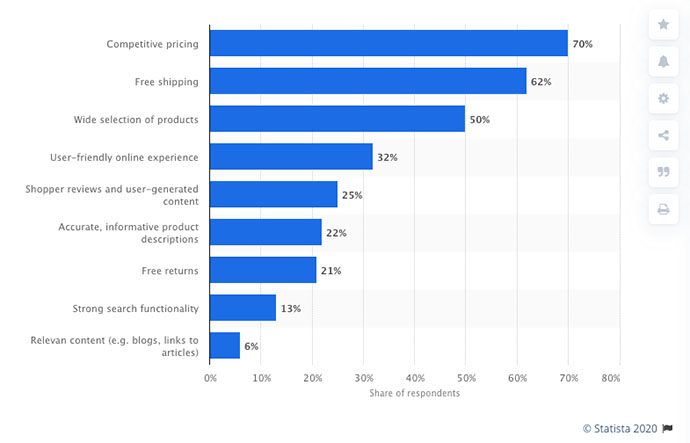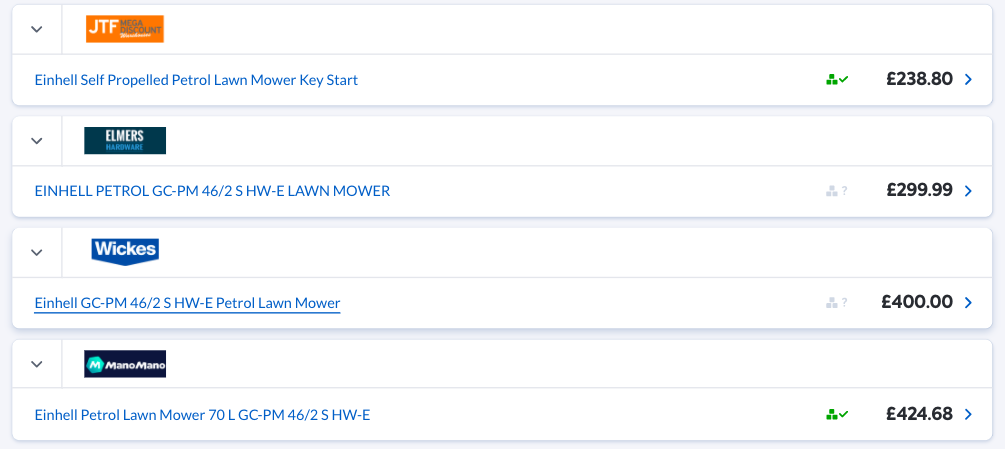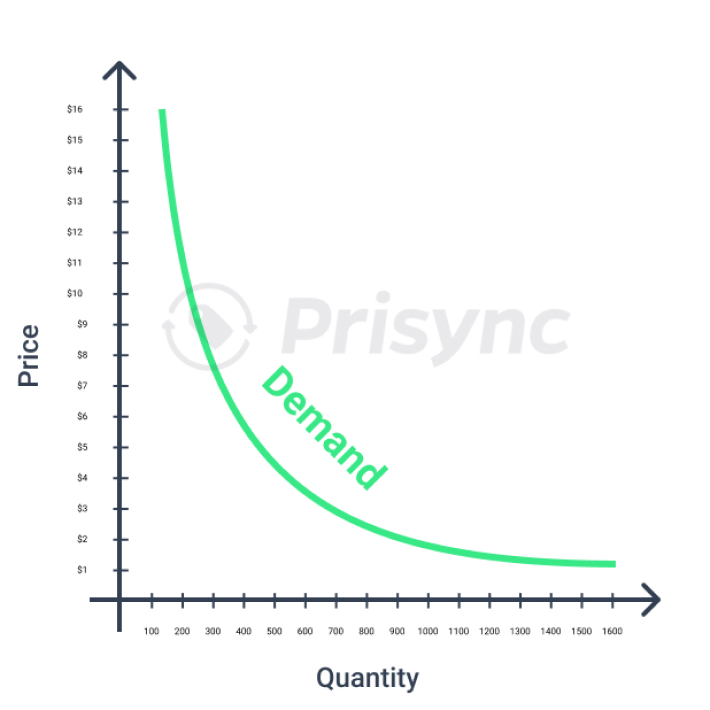70% of US shoppers say competitive pricing is the most important factor when choosing a retailer.
To a lesser extent, it’s still a major factor with other types of services. Every business owner must acknowledge the fact that without a solid pricing strategy, there is no way to survive the competition.
Pricing optimization strategies enable you to make data-driven pricing decisions—which is the key to acquiring new customers, keeping your existing customers pleased, and improving profitability.
In this guide, you’ll learn about four effective pricing optimization strategies to help you convert more people into customers.
Let’s dive in.
Table of Contents
Use competitive pricing based on data for pricing optimization
For years, businesses pursued the cost-plus pricing strategy. It’s one of the easiest methods to price a product: just calculate the cost and add a markup.
Back then, most only had local competition which consisted of a few stores. Shoppers had limited options because there were constraints on their ability to move from one area to another.
Cost-plus pricing worked for a lot of businesses then.
But the nature of the competition has changed since it moved online:
- Competitors pop up every day, leading to fierce competition
- Modern shoppers are price sensitive
- Shoppers can compare prices (using comparison shopping engines like Google Shopping)
In a fiercely competitive environment where shoppers demand the best on-site experience, fastest shipping, shipment tracking, and excellent customer service at the best price, focusing on one of these aspects cannot guarantee success. Instead, entrepreneurs must constantly improve all aspects of the customer experience and offer it at a competitive price.
In fact, among all factors that influence people to choose a retailer, price is the most important one.

To compete on price, you have to track competitor prices. Here are the three commonly used price tracking methods with distinct advantages and disadvantages:
Manual tracking
In theory, you can manually collect competitor price data. Is it practical? Not exactly.
Manually tracking 40 products from 20 online stores takes approximately 10 hours. But online prices change much more frequently. By the time you’re done, the data is likely to become old and irrelevant.
But of course, most online retailers have more products in their assortment, and likely more competitors. So in real life, manual tracking is not manageable.
In-house engine
Another option is to hire professionals to build an in-house engine that automatically tracks competitor prices.
In the early 2010s, Amazon built its own price tracking and repricing engine, which helped the company dominate the US online retail market. It was a key component of the retail behemoth’s success and it had an impact beyond imagination.
Before Amazon built its engine, sellers would keep prices constant for nine months on average. That number drastically increased throughout the past ten years and Harvard Business School Professor Alberto Cavallo named this trend the Amazon effect.
Now more than ever, business owners know that sticky prices undermine their competitive strength. But not all businesses have the resources to build an in-house engine.
Instead, you can hire a web scraping service company to build it for you. On average, the initial setup costs a little over $200. But like all software, this too will require monthly maintenance, which takes another $177 monthly.
When searching for professionals to simplify scraper tools for your business, consider experts who can develop specialized tools like a Walmart product finder, streamlining the process of locating products.
However, the true power of web scraping lies not just in its ability to collect data, but in the artful orchestration of that data to paint a vivid picture of the competitive landscape.
Like a master conductor guiding an orchestra, a skilled data strategist must wield web scraping tools with finesse, coaxing out the hidden melodies of market trends and competitor behavior.
By harmonizing the disparate strands of data into a cohesive tapestry, businesses can compose a symphony of insights that resonates with their unique brand identity and market position.
By harmonizing the disparate strands of data into a cohesive tapestry, businesses can compose a symphony of insights that resonates with their unique brand identity services and market position.
Investing in skilled professionals who can tailor scraper tools to meet specific business needs enhances efficiency and ensures the extraction of relevant data for informed decision-making.
This approach not only saves time but also provides a competitive edge by enabling quick responses to market changes. Additionally, custom scraper tools can integrate seamlessly with your existing systems, ensuring a smooth workflow and minimizing disruptions.
Also, some scraping services allow you to pay $10 per website.
If you need more features than a simple scraping tool can offer, you can hire people to build a fully functional customized in-house engine. You’d pay for the features that you need.
For example, you can include a dynamic pricing function that’ll adjust your prices according to the changes in competitor prices. If you want to be the cheapest in the market, it’ll allow you to hold on to your price positioning without making manual adjustments.
Note that maintaining complex software like this will require technical expertise and the maintenance will cost a lot.
Price tracking software
Price tracking software tends to be easy to use and doesn’t require technical knowledge to get started. It allows you to monitor all your competitors and see their prices on a single dashboard.
You can see where your prices stand against competitors’ in each product, brand, and category, allowing you to understand why some products perform better than others and make data-driven decisions to get rid of slow-moving stock.
For example, if a once-popular product became dead stock without an apparent reason, but notice that competitors are offering it at a much lower price. You can lower the price of your product and see if it’ll affect demand. If it does, you know that competitors were pricing you out of the market.
Or, if all competitors have better prices than you but you can’t lower the price without selling at a loss, it’ll be revealed immediately after you put in your cost information to the system. That way, unprofitable products will no longer take space in your inventory and you won’t allocate any resources to market them.
Also, the best software includes a repricing feature, allowing you to automatically adjust prices based on your costs and competitor prices.
Many retailers rely on repricing software to stay competitive on marketplaces like Amazon, using real-time automation to align with pricing rules and boost sales while protecting profit margins.
Based on your brand positioning, you can set cost-based and market-based smart pricing rules like:
- My price should be $15 cheaper than my cheapest competitor but not lower than 5% + cost.
- My price should be 5% cheaper than the average price but not lower than 10% + my cost.
If you’re selling products that could be found in numerous other online stores, above-average prices will drive shoppers away from your store. Why would they pay more to you when most stores have similar order fulfillment processes and delivery times?
- My price should be the cheapest
If you can afford to operate on thin profit margins, this rule will help you acquire new customers in a short period of time. But don’t forget that bargain hunters will always look for the best price, so don’t assume that they’ll become loyal customers once after they buy from your store.
- My price should be 15% higher than the most expensive competitor
If you’re selling luxury products, don’t lower your prices below average. Luxury consumers are driven by the exclusiveness of an item, and the cheaper the price, the more accessible it is. Above-average prices will be consistent with your brand positioning.
The major disadvantage is that you can’t customize the SaaS—some have room for customization, only to a limited extent—according to your needs.
Test prices regularly
Testing is a central element of pricing optimization. It helps you stay competitive while improving profitability.
When a product runs out of stock in other stores, test higher prices.
Unfortunately, most retailers still don’t have price intelligence. So this opportunity often goes unnoticed.

You can see that the seller could increase the price and drastically increase the profit margins without affecting their sales. In other words, they’re leaving money on the table.
But even when there is no apparent reason to increase or decrease prices you shouldn’t stop testing. Here’s why:

This is a demand curve—a hypothetical one—with many price points on it. At each point both profitability and demand change. The only way to make sure you have the optimal price—the price and demand balance that’ll result in the highest profit—is to test different points and measure the change in demand.
Suppose producing a good costs you $7. When you sell it at $10, 50 people buy it. At $15, 15 people buy it. In the first scenario, your profit is $150, and in the latter, it’s $120. In a market of 200 buyers, you can effectively measure demand via market research. However, in real life, we can’t ask each and every potential buyer to find out how many people will purchase at each price point.
Instead, you can survey a sample group to find out their willingness to pay for a product.
To test prices, use the above mentioned smart pricing rules.
When competitors increase their prices, these smart rules will adjust yours too. So when there is a possibility of improving profit margins, the rules you’ve set will make sure you’re not leaving money on the table.
Like we’ve mentioned before, sticky prices undermine your competitive strength. Continue testing whenever there is an opportunity born out of changing market prices.
Analyze historical trends
If you want to stay ahead of the game, you need to do more than short-term planning.
After tracking competitor prices the next logical step is to dig into historical price data. Analyzing historical data will help you:
- Reveal patterns in competitor behavior
- Develop counter-strategies
- Understand market trends
When do they offer discounts? Who offers the most competitive prices for certain products, categories, or brands?
If there is a recurring time interval between discount campaigns, say, Black Friday and Cyber Monday discounts, and you reveal it, they won’t be able to catch you off guard next year. You’ll be able to get a jump on their discount campaigns with counter-campaigns, avoid losing customers, and even attract new ones.
In the realm of marketing strategy, leveraging the periodicity of discount campaigns, such as the highly anticipated Black Friday and Cyber Monday discounts, is akin to mastering the ebb and flow of consumer behavior. The intricate dance between revealing and strategically concealing your discount patterns empowers you with the foresight to stay ahead of the competition.
Unveiling the timing of your promotions not only shields you from being caught off guard but also opens the door to orchestrating counter-campaigns that can not only retain your customer base but also allure new patrons with the irresistible allure of exclusive discounts.
Embracing the burstiness of your promotional endeavors during events like Black Friday and Cyber Monday is not just a tactical move; it’s a strategic play that intertwines perplexity and anticipation in the intricate tapestry of customer engagement.
Apart from this, historical price analysis reveals other useful information that’ll give you leverage when negotiating with suppliers.
If competitors always have better prices for a certain product, and you can’t lower the price as much as them, there is a good chance that the supplier gives them lower prices. You can ask for a better price. It’s leverage that may turn into an advantage.
Keep in mind that there may be many factors in play that allow your competitors to negotiate a better price with suppliers.
What’s more, observing market prices will give you a better understanding of the trends and allow you to capitalize on them.
For instance, if everyone is increasing the price of a product, it’s likely that the product is in high demand. Make sure you supply it, offer a good price if you can, and hopefully acquire new customers.
Offer personalized discounts
Isn’t it frustrating when customers abandon their carts? They come through all the stages in the purchase funnel and leave at the last stage. It means you’ve worked hard and captured their attention but failed to convert them.
Most people abandon their carts because of the high extra costs. The extra costs can be taxes, duties, shipping costs, etc. Some of these are beyond your control, but you can often cover the shipping costs or include them in the price.
But a truly effective way to convert more people is by offering them discounts on the products they are interested in.
If a shopper has shown interest in a product for a while but never completed the purchase, give them a personal discount they can use on that product.
Say a person added a dress to their wishlist, but never bought it. Send them an email asking if they’d be interested in receiving a personal discount that could be applied to that dress.
You don’t have to just offer discounts to online buyers. You can offer discounts to in-store shoppers as well. Something such as a cash discount program can help your business immensely. You’ll be saving on the credit card processing fees when you get paid in cash. And when you offer a discount, people will buy more.
It’ll not only entice them to buy but also let them know you’re paying attention to their interests and needs. So in the short run, it’ll help you improve your conversions, and in the long run, it’ll help you build a loyal customer base.
Parting Words
Even though there is growing interest in personalization, brand values, brand image, etc., price is still one of the most important factors for the modern shopper.
That’s why e-commerce owners have to make data-driven pricing decisions to offer competitive pricing, improve profit margins, reveal competitor behavior and develop counter-strategies, and offer personalized discounts.
Apply what you’ve learned and let us know the results.
Basak Saricayir is the content marketer at Prisync which helps E-commerce companies increase sales by tracking prices automatically from any marketplace around the world.